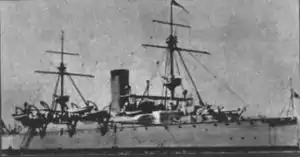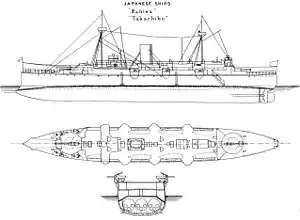Naniwa-class cruiser
The two Naniwa-class cruisers (浪速型防護巡洋艦, Naniwa-gata bōgojun'yōkan) were protected cruisers operated by the Imperial Japanese Navy. Both participated in numerous actions during the First Sino-Japanese War and in the Russo-Japanese War.
 Japanese cruiser Naniwa | |
| Class overview | |
|---|---|
| Name: | Naniwa class |
| Builders: | Armstrong Whitworth, United Kingdom |
| Operators: |
|
| Preceded by: | Izumi |
| Succeeded by: | Unebi |
| Built: | 1884–1885 |
| In commission: | 1886–1914 |
| Completed: | 2 |
| Lost: | 2 |
| General characteristics | |
| Type: | Protected cruiser |
| Displacement: | 3,650 long tons (3,709 t) |
| Length: | 91.4 m (299 ft 10 in) |
| Beam: | 14 m (45 ft 11 in) |
| Draught: | 6.4 m (21 ft 0 in) |
| Propulsion: | 2-shaft reciprocating engines; 6 boilers; 7,604 hp (5,670 kW) |
| Speed: | 18.5 knots (21.3 mph; 34.3 km/h) |
| Range: | 9,000 nmi (17,000 km) at 13 kn (24 km/h) |
| Complement: | 357 |
| Armament: |
|
| Armour: |
|
Background
The revolutionary design of the "Elswick" protected cruiser, initially developed as a private-venture by Armstrong Whitworth in the mid-1880s, and implemented in the cruiser Esmeralda for the Chilean Navy (subsequently purchased by Japan as Izumi) was of great interest to Japan because of her high speed, powerful armament, armor protection and relatively low cost, especially since the Imperial Japanese Navy lacked the resources at the time to purchase modern pre-dreadnought battleships.[1] This was a period of increasing tension with the Empire of China prior to the First Sino-Japanese War, and Japan lacked the ships necessary to counter the Chinese Beiyang Fleet.
Pioneering Japanese naval architect Sasō Sachū requested that Armstrong Whitworth make modifications to the Esmeralda design to customize it for Japanese requirements, and two vessels, Naniwa and Takachiho were ordered under the 1883 fiscal year budget, by Naval Minister Kawamura Sumiyoshi. When completed, Naniwa was considered the most advanced and most powerful cruiser in the world.[2][3] However, the extremely fast development of technology, weaponry and armor in this field of ship design meant that the supremacy of this design was very short.
Naniwa and Takachiho together cost £546,980. Prince Yamashina Kikumaro attended the launch, and afterwards had dinner with Baron William Armstrong, who made a toast that "the ship was destined to the service of a country which was likely never to come into collision with our own peace-loving country".
Design

The hull of the Naniwa-class cruiser was a typical flush deck with high freeboard to improve seaworthiness. The design came with a ram attached to the reinforced bow, which was standard practice for the time.[4]
As built, her main armament initially consisted of two 260 mm (10 in) L/35 Krupp cannons mounted individually on rotating platforms in the bow and stern, with a supply of 200 rounds per gun. Secondary armament was initially six 150 mm (5.9 in) L/35 Krupp cannons mounted in semi-circular sponsons on the main deck, with 450 rounds per gun. Light armament included six QF 6 pounder Hotchkiss guns, ten 1-inch Nordenfelt guns and four 11-mm, 10-barrel Nordenfelt guns. In addition, there were four 356 mm (14.0 in) Whitehead torpedo tubes mounted on the main deck. After the First Sino-Japanese War, both Naniwa and Takachiho were re-armed with eight Elswick QF 6 inch /40 naval guns in order to increase stability and standardize on ammunition for the fleet.
Propulsion was by two horizontal two-stage steam reciprocating engines, two-shafts, with six boilers, yielding a speed of 18 knots (33 km/h) and a range of 9,000 nautical miles (17,000 km) at 13 knots (24 km/h) based on its capacity for 800 tons of coal.[4]
Ships in class
Two Naniwa-class cruisers were purchased from Armstrong Whitworth in England. Naniwa was lost before the start of World War I, Takachiho was lost soon after hostilities commenced.[5]
Ordered in 1883, launched 18 March 1885, and completed 1 December 1885, Naniwa played a major role in the First Sino-Japanese War, notably at the Battle of Pungdo and the Battle of the Yellow Sea. During the Russo-Japanese War she was present at the opening Battle of Chemulpo Bay, but was subsequently assigned a reserve role. After the war, she was lost after running aground on 26 July 1910 on the coast of Urup, in the Kurile Islands .[5]
Ordered in 1883, launched 16 May 1885, and completed 1 December 1885, Takachiho participated in the Battle of the Yellow Sea in the First Sino-Japanese War. In the Russo-Japanese War she was present at the opening Battle of Chemulpo Bay, but was subsequently assigned a reserve role. In World War I, while covering the invasion of German-held Tsingtao, she was torpedoed by the German torpedo boat S90 on 14 October 1914 and sank with the loss of 271 officers and men.[5]
Notes
- Brooke, Warships for Export page 58-60
- Jentsura, Warships of the Imperial Japanese Navy;
- Evans, Kaigun, p. 15.
- Chesneau, Conway's All the World's Fighting Ships, 1860–1905, p. 226-227.
- Brooke, p. 58-60.
References
- Brooke, Peter (1999). Warships for Export: Armstrong Warships 1867-1927. Gravesend: World Ship Society. ISBN 0-905617-89-4.
- Chesneau, Roger (1979). Conway's All the World's Fighting Ships, 1860–1905. Conway Maritime Press. ISBN 0-85177-133-5.
- Evans, David C.; Peattie, Mark R. (1997). Kaigun: Strategy, Tactics, and Technology in the Imperial Japanese Navy, 1887-1941. Annapolis, MD: Naval Institute Press. ISBN 0-87021-192-7.
- Howarth, Stephen (1983). The Fighting Ships of the Rising Sun: The Drama of the Imperial Japanese Navy, 1895-1945. Atheneum. ISBN 0-689-11402-8.
- Jentsura, Hansgeorg (1976). Warships of the Imperial Japanese Navy, 1869-1945. Annapolis, MD: Naval Institute Press. ISBN 0-87021-893-X.
- Roberts, John (ed). (1983). 'Warships of the world from 1860 to 1905 - Volume 2: United States, Japan and Russia. Bernard & Graefe Verlag, Koblenz. ISBN 3-7637-5403-2.
- Schencking, J. Charles (2005). Making Waves: Politics, Propaganda, And The Emergence Of The Imperial Japanese Navy, 1868-1922. Stanford University Press. ISBN 0-8047-4977-9.
External links
| Wikimedia Commons has media related to Naniwa class protected cruisers. |